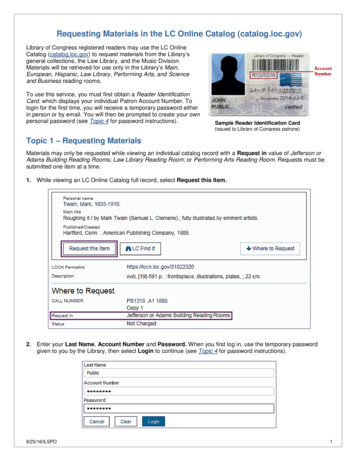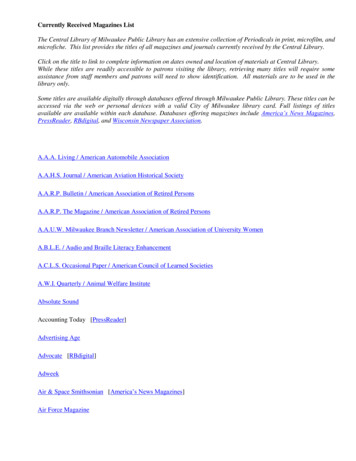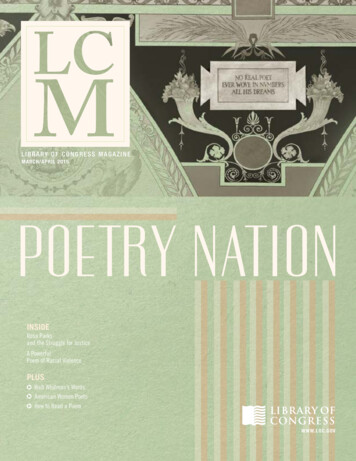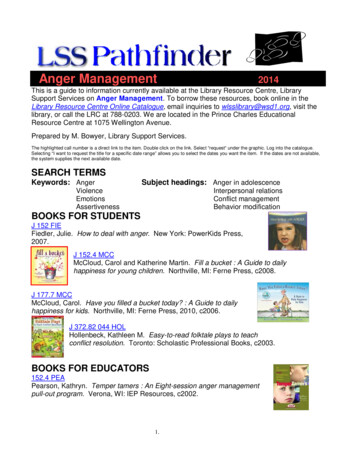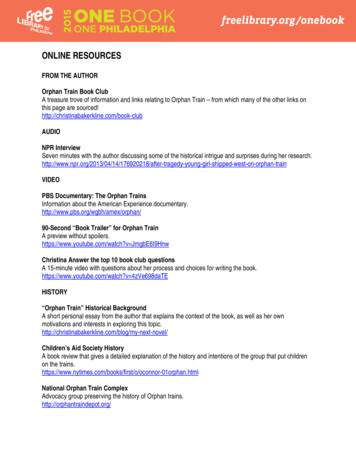
Transcription
ONLINE RESOURCESFROM THE AUTHOROrphan Train Book ClubA treasure trove of information and links relating to Orphan Train – from which many of the other links onthis page are DIONPR InterviewSeven minutes with the author discussing some of the historical intrigue and surprises during her inVIDEOPBS Documentary: The Orphan TrainsInformation about the American Experience -Second “Book Trailer” for Orphan TrainA preview without spoilers.https://www.youtube.com/watch?v JmgbE6I9HnwChristina Answer the top 10 book club questionsA 15-minute video with questions about her process and choices for writing the book.https://www.youtube.com/watch?v 4zVe698daTEHISTORY“Orphan Train” Historical BackgroundA short personal essay from the author that explains the context of the book, as well as her ownmotivations and interests in exploring this novel/Children’s Aid Society HistoryA book review that gives a detailed explanation of the history and intentions of the group that put childrenon the or-01orphan.htmlNational Orphan Train ComplexAdvocacy group preserving the history of Orphan trains.http://orphantraindepot.org/
Orphan Train Rider StoriesWritten testimonials from riders who were sent in the 1900’s, 1910’s, and rider-stories/
PRINT RESOURCESOrphan Train Historical BackgroundI am interested in exploring how people tell thestories of their lives and what these stories reveal(intentionally or not) about who we are. I amintrigued by the spaces between words, the silencesthat conceal long-kept secrets, the elisions that beliesurface appearance. And I am interested in thepervasive and insidious legacy of trauma – the wayevents beyond our control can shape and define ourlives. All of my books address these themes.Like my four previous novels, my novel Orphan Train is about cultural identity and family history. For thefirst time, however, I am undertaking a project that requires a large amount of historical, cultural, andgeographical research. My novel traces the journey of Vivian Daly, a now-90-year-old woman, from a smallvillage in Ireland to the crowded streets of the Lower East Side to the wide-open expanses of the Midwestto the coast of Maine. Her life spans nearly a century, encompassing great historical change and upheaval.Change has been the defining principle of Vivian Daly’s life, and from a very young age she learned toadapt, to inhabit new identities. For many reasons, she has told no one about her early life: her difficultchildhood in Ireland and the lies and secrets thatpropelled her, alone, toward a frighteningly openended future. She spent her entire adult life minimizingrisk, avoiding complicated entanglements, and keepingsilent about the past. But now, through a series ofevents, she encounters a stranger who wants to knowher story. As Vivian begins to face the truth about whathappened long ago, the past becomes more and morepresent for her. Vivian’s recollections come in tiers: herturbulent adulthood in the Midwest; her early life on theLower East Side of Manhattan, living in a tenement;and finally, her childhood in Kinvara, on the westerncoast of Ireland.Orphan Train is a specifically American story ofmobility and rootlessness, highlighting a little-known but historically significant moment in our country’spast. Between 1854 and 1929, so-called “orphan trains” transported more than 200,000 orphaned,abandoned, and homeless children – many of them first-generation Irish Catholic immigrants – from thecoastal cities of the eastern United States to the Midwest for “adoption” (often, in fact, indenturedservitude). Charles Loring Brace, who founded the program, believed that hard work, education, and firmbut compassionate childrearing – not to mention Midwestern Christian family values – were the only way tosave these children from a life of depravity and poverty.
The children, many of whom had experienced great trauma in their short lives, had no idea where therewere going. The train would pull into a station, and townspeople assembled to inspect them – often literallyscrutinizing teeth, eyes, and limbs to determine whether a child was sturdy enough for field work orintelligent and mild-tempered enough to cook and clean. Babies and healthy older boys were typicallychosen first; older girls were chosen last. After abrief trial period, the children became indentured totheir host families. If a child wasn’t chosen, he orshe would get back on the train to try again at thenext town.Some children were welcomed by new familiesand towns. Others were beaten, mistreated,taunted, or ignored. They lost any sense of theircultural identities and backgrounds; siblings wereoften separated, and contact between them wasdiscouraged. City children were expected toperform hard farm labor for which they wereneither emotionally nor physically prepared. Manyof them, first-generation immigrants from Italy,Poland, and Ireland, were teased for their strange accents; some barely spoke English. Jealousy andcompetition in the new families created rifts, and many children ended up feeling that they didn’t belonganywhere. Some drifted from home to home to find someone who wanted them. Many ran away. TheChildren’s Aid Society did attempt to keep track of these children, but the reality of great distances andspotty record-keeping made this difficult.I became interested in the story of the orphan trains because my husband’s grandfather, Frank Robertson,was rumored to have been a train rider. It was believed that he traveled on an orphan train from New Yorkto Jamestown, North Dakota with his four siblings when he was ten years old. In the course of researchingthis family lore, I found that although orphan trains did, in fact, stop in Jamestown, and orphans from thesetrains were adopted there, the Robertson clan came from Missouri. But my interest was piqued, and Istarted researching this period in history.After reading newspaper clippings, I began searching the Web for more information. I found first-personaccounts, orphan-train reunion groups, and historical archives. That research led me to New York PublicLibrary, where I found original materials: lists of orphans from foundling hospitals, handwritten records,notes from desperate mothers explaining why they were abandoning their children. I found thatapproximately 145 orphan train riders are still alive in the United States; orphan-train reunions are stillbeing held in towns across the Midwest. A novel began to take shape in my mind.My own background is partly Irish, and so I decided that I wanted to write about an Irish girl who has keptsilent about the circumstances that led her to the orphan train. “People who cross the threshold betweenthe known world and that place where the impossible does happen discover the problem of how to conveythat experience,” Kathryn Harrison writes. Over the course of this novel Vivian moves from shame about
her past to acceptance, eventually coming to terms with she’s been through. In the process she learnsabout the regenerative power of claiming – and telling – one’s own life story.In Orphan Train, Vivian Daly’s first-person, past-tense account of her experience on the orphan train andher journey from Irish-Catholic immigrant to Protestant Midwesterner alternates with the present-day,present-tense, third-person-limited story of Vivian’s life on the Maine coast. (I have quite a bit ofexperience with this kind of autobiographical narrative, and am intimately familiar with its quirks, subtexts,and possibilities. Some time ago I wrote a nonfiction book with my mother called The Conversation Begins:Mothers and Daughters Talk about Living Feminism, for which we interviewed, and created first-personaccounts for, more than 60 women.) The present-day story takes place over six weeks; the narrative arc ofVivian’s history encompasses 90 years.Orphan Train Rider Story: Marguerite Thompson ies/marguerite-thompson/The Larsons had two sons other than Teddy. My new Papa was a big man with amoustache and a kind face. The Larsons were of the upper class in that area. Theyhad a lady that came and washed the clothes on a wash board. Another lady made all ofour clothes except for our underwear. Mrs. Larson (Mama) would make all of ourunderwear.My new home was a big two story house with 10 rooms, but we didn’t have any electricity.The house was beautiful inside. I didn’t have a bedroom of my own;I slept on the couch in the front room on a feather mattress Mama would take out of hercloset every night. After a few weeks, she said I could do it myself. The boys hadbedrooms upstairs. Teddy and I were not permitted to use the bathroom. We had to usethe outside toilet, and on Saturday we would drag a galvanized bathtub from the backporch and put it by the cook stove.Mama didn’t like my New York accent at all. She wanted me to talk like they did, so I was slapped quiteoften in the mouth. Sometimes I would wonder what I had done wrong.I had only been there a few weeks when Teddy brought out a china doll to play with. He said it was his andI couldn’t play with it. Well one day I found it and took outside and broke it. I got my first whipping.They rented out three of the bedrooms to salesmen. When I was six, Teddy and I started school. When wecame home from school, we had to wash the dinner dishes from noon. Then we had to go upstairs andmake the beds, dust mop the floors and clean the bathroom. We didn’t dare use the toilet, she said it tooktoo much water. By the time we got through with that, it was time to set the table for supper. I always onlyhad one helping put on my plate. Teddy and Charles always had milk to drink with their dinner, but she saidI couldn’t have any.They had two cows and a lot of milk, and Teddy and I would deliver it both morning and night. Charles (age14) went with us a few times until we could do it on our own. Sometimes I went by myself, especially if it
was cold. One morning on my way to school, it was so cold that the sidewalks were very icy, and I slippedand fell. One bucket of milk hit the sidewalk, the lid blew off, and half of the milk spilled out. Well, I got up,put the lid back on, and set it on the porch where it was supposed to go. The lady called my foster motherand wanted to know why she didn’t get a full quart of milk. When I went home at noon, my foster mothertold me about it and wanted to know if I drank some of it. I told her what had happened, and she said I waslying. Then she got the rawhide whip and didn’t even care where she hit me.Between the ages of six and eleven I got many whippings. I can truthfully say I never got enough to eat.When I would come home from school and go to the pantry to get a piece of bread and butter, she said Iwas stealing it, because I didn’t ask for it.Once a year, Mr. McPhealy would come from the New York Foundling Home to see how I was gettingalong. I had to tell him fine. I would have to speak a piece for him, or poetry as it is called now. The name ofit was “Looking on the Bright Side.” Then I had to dance the Irish jig for him, and when I was through, I wasexcused. I would go outside and cry and wish he would take me back with him. I wanted to tell him the truthabout how I was treated, but I couldn’t. Still, she would whip me if she thought I was lying. I often wonderedwhy Papa Larson didn’t ever have anything to say about the way she treated me, but it seemed to me likeshe ruled the house.”
Orphan Train Book Club. A treasure trove of information and links relating to Orphan Train - from which many of the other links on this page are sourced! . In Orphan Train, Vivian Daly's first-person, past-tense account of her experience on the orphan train and





